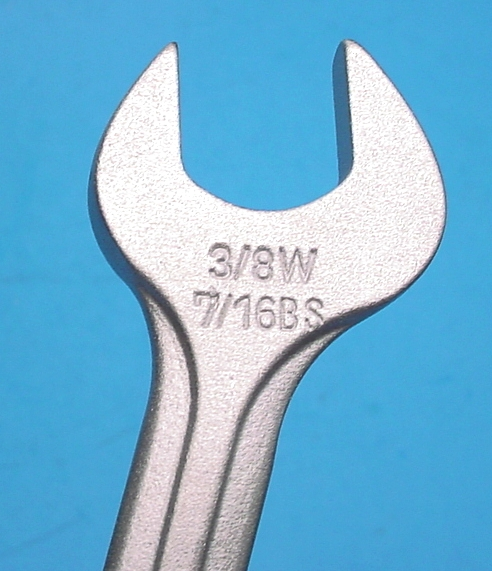Post by Admin on Nov 24, 2023 9:32:45 GMT -7
From Wikipedia, the free encyclopedia
British Standard Whitworth (BSW) is an imperial-unit-based screw thread standard, devised and specified by Joseph Whitworth in 1841 and later adopted as a British Standard. It was the world's first national screw thread standard, and is the basis for many other standards, such as BSF, BSP, BSCon, and BSCopper.

To simplify matters, the term hexagon is used in this section to denote either bolt head or nut.
Two spanners, both nominal size 5⁄8 in, with a diagram superimposed to show the logic that allows them both to be nominal size 5⁄8 in when their actual sizes are clearly different (across-flats distance vs screw diameter). The across-flats definition is the common standard today, and has been for many decades. The larger spanner in this photo is from the 1920s or earlier. Its face was polished to allow the size stamp to show well in the photograph. This example is American, but it illustrates the way that spanners for Whitworth fasteners were typically labelled.
Whitworth and BSF spanner markings refer to the bolt diameter, rather than the distance across the flats of the hexagon (A/F) as in other standards. Confusion can arise because each Whitworth hexagon was originally one size larger than that of the corresponding BSF fastener. This leads to instances where for example, a spanner marked 7⁄16 BSF is the same size as one marked 3⁄8 W. In both cases the spanner jaw width of 0.710 in, the width across the hexagon flat, is the same.
Certain branches of industry used Whitworth fasteners with a smaller hexagon (identical to BSF of the same bolt diameter) under the designation "AutoWhit" or Auto-Whit[citation needed] [7] and this series was formalised by the British Engineering Standards Association in 1929 as standard No. 193, with the 'original' series being No. 190 and the BSF series No. 191.[8]

During World War II the smaller size hexagon was adopted more widely to save metal[9] and this usage persisted thereafter. Thus it is today common to encounter a Whitworth hexagon which does not fit the nominally correct spanner and following the previous example, a more modern spanner may be marked 7⁄16 BS to indicate that they have a jaw size of 0.710 in and designed to take either the (later) 7⁄16 BSW or 7⁄16 BSF hexagon.[10][11][12]
Whitworth fasteners with the larger hexagons to BS 190 are now often colloquially referred to as 'pre-war' size, even though that is not strictly correct.
British Standard Whitworth (BSW) is an imperial-unit-based screw thread standard, devised and specified by Joseph Whitworth in 1841 and later adopted as a British Standard. It was the world's first national screw thread standard, and is the basis for many other standards, such as BSF, BSP, BSCon, and BSCopper.

To simplify matters, the term hexagon is used in this section to denote either bolt head or nut.
Two spanners, both nominal size 5⁄8 in, with a diagram superimposed to show the logic that allows them both to be nominal size 5⁄8 in when their actual sizes are clearly different (across-flats distance vs screw diameter). The across-flats definition is the common standard today, and has been for many decades. The larger spanner in this photo is from the 1920s or earlier. Its face was polished to allow the size stamp to show well in the photograph. This example is American, but it illustrates the way that spanners for Whitworth fasteners were typically labelled.
Whitworth and BSF spanner markings refer to the bolt diameter, rather than the distance across the flats of the hexagon (A/F) as in other standards. Confusion can arise because each Whitworth hexagon was originally one size larger than that of the corresponding BSF fastener. This leads to instances where for example, a spanner marked 7⁄16 BSF is the same size as one marked 3⁄8 W. In both cases the spanner jaw width of 0.710 in, the width across the hexagon flat, is the same.
Certain branches of industry used Whitworth fasteners with a smaller hexagon (identical to BSF of the same bolt diameter) under the designation "AutoWhit" or Auto-Whit[citation needed] [7] and this series was formalised by the British Engineering Standards Association in 1929 as standard No. 193, with the 'original' series being No. 190 and the BSF series No. 191.[8]

During World War II the smaller size hexagon was adopted more widely to save metal[9] and this usage persisted thereafter. Thus it is today common to encounter a Whitworth hexagon which does not fit the nominally correct spanner and following the previous example, a more modern spanner may be marked 7⁄16 BS to indicate that they have a jaw size of 0.710 in and designed to take either the (later) 7⁄16 BSW or 7⁄16 BSF hexagon.[10][11][12]
Whitworth fasteners with the larger hexagons to BS 190 are now often colloquially referred to as 'pre-war' size, even though that is not strictly correct.
